My initial experience trying to find the best moodboard maker has felt quite overwhelming. As a photographer and graphic designer, I’m frequently working on multiple projects at the same time, so having a moodboard as a reference point can be very helpful. Originally, I was relying solely on screenshots, Pinterest, and random files saved on my PC, but it was impossible to have a cohesive vision with such an approach.
Between planning shoots, creating interior designs, coming up with brand concepts, and working on marketing campaigns, moodboards can be extremely useful for establishing a cohesive centerpiece that can convey my vision to other people and help me stay organized.
Currently, I’m in the process of putting together my own photography studio, and I'm considering multiple interior design options. I wanted to visualize the different combinations of colors, textures, lights, and furniture before committing to a decision in real life.
I think that a good moodboard app needs to offer speed and user-friendly controls. I like to gather inspiration from different sources, including pictures I found online, my personal photos, color schemes, and material samples that I all add to a single board. A proper solution needs to allow me to freely arrange elements, try different layouts, and combine various textures and lighting settings.
I also often collaborate with my teammates when working on complex projects or when I require feedback, so it’s a plus when a tool allows me to share my work conveniently. I also appreciate it when an app provides AI-based recommendations that can help me arrive at a coherent vision without compromising my creativity.
Lastly, a moodboard maker has to be a good fit for my overall workflow, enabling me to switch between boards while providing enough space and flexibility to properly organize my ideas. For my photography studio planning, I needed a solution that could visualize the different aspects of the project in a way that helps me piece all the different elements, from color palettes to furniture, together.
To ensure my review is thorough, I approached my coworkers from the FixThePhoto team and asked them to help me try out all the apps that have the highest user scores or were recommended by people on specialized forums.
A moodboard is basically a collage that can include photos, color schemes, textures, fonts, and captions or sketches that help convey the style and message of a project. It’s primarily made to convey the core of an idea before you start bringing it to life, serving as a guide that ensures the creator and collaborators/clients share the same vision. In contrast to final designs, moodboards are about exploration and setting expectations while also evoking a specific emotional response.
Where moodboards are usually used:
Before you can start using any mood board app, you first have to come up with a defined vision for your project. Determine the desired mood you’ll be going for, be it minimalism, retro charm, or striking, high-energy vibes. Afterward, you can start collecting visuals, fonts, textures, and color schemes that tie into your concept. Having gathered enough materials, you can organize them on a virtual or physical board before adjusting its layout to achieve a cohesive look.
Even though each step on its own is simple, there are many other factors you have to consider depending on the exact type of project you have in mind.
Moodboard for interior design. When working on interior design moodboards, I prioritize finding appropriate textures, finishes, and color palettes that will be a good match for the space I have in mind. I include fabric swatches, flooring previews, and paint templates, as well as photos of furniture and décor items. The resulting layout allows me to envision how the chosen elements can be combined and how they look in various lighting conditions.
It’s also important to remember seasonal adaptability. A space has to look welcoming all year round, not just in the summer. That’s why I prefer to add versatile elements, focusing on base colors and timeless furniture, which can be adjusted depending on the season with relevant accents. By combining digital visuals and physical samples, I can visualize how certain tones and textures match in real life, ensuring the moodboard provides a useful preview of the final design.
Moodboard for a photoshoot. When I need to create a mood board for a photoshoot, the focus shifts from materials to lighting, styling, and storytelling. Lighting is particularly important, hence why I like to add references showcasing diffused, natural settings, striking contrasts, or dramatic effects based on the atmosphere I want to convey.
Fashion shoots put a premium on motion and composition, which is why I love including pose references and sample photos that will later smooth the cooperation between the photographer and the model. Accessory and wardrobe coordination is also essential, as you need to ensure all props, backdrops, and chosen attire match the style you’re envisioning. This way, you can be certain the final photos look deliberate and well-thought-out.
Fashion moodboard. The process of devising a fashion mood board resembles the telling of a visual narrative that helps unify the entire collection. I prefer to first find reference photos of models, fabrics, and runway looks that match the general theme. The color palette needs to tie the project together, whether you’re designing an outfit or assets for the marketing campaign.
The key distinguishing feature of this type of moodboard is that fashion values movement as much as aesthetics. I tend to provide references to how fabrics drape, flow, or shimmer in motion. This allows me to envision how the clothes will look on the catwalk. The space is also important, which is why I recommend adding photos of it to the board, ensuring none of the elements you chose will look out of place.
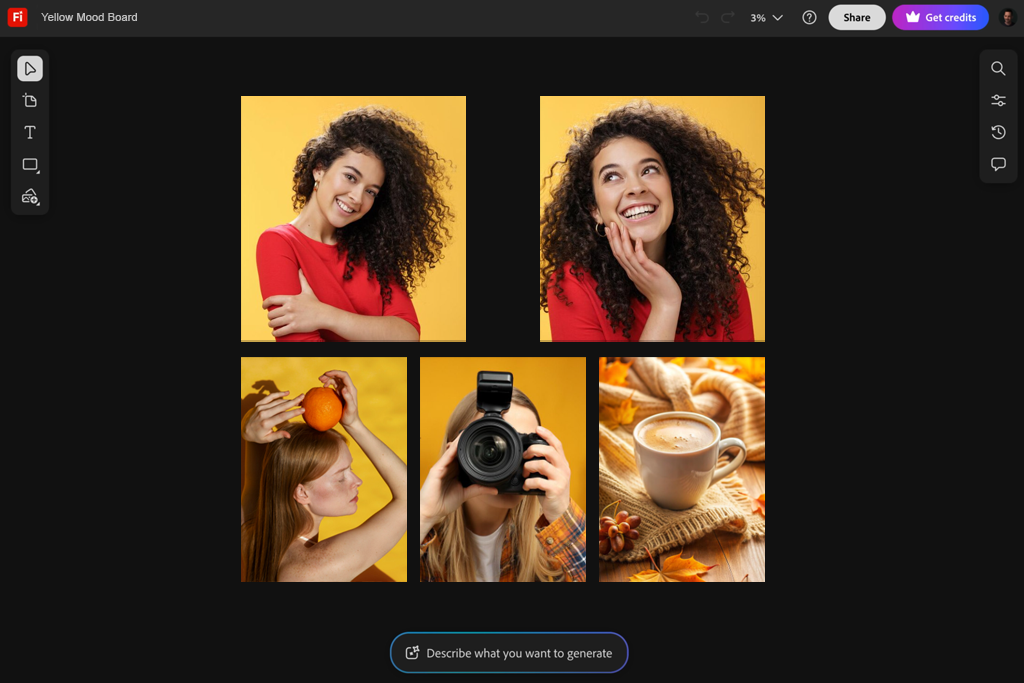
During my search for reliable mood board software, I was hoping to find a solution that could put together various kinds of references with speed and efficiency. Adobe Firefly fit the bill perfectly. Not only does it belong to the Adobe ecosystem, but it also lets me leverage images, color palettes, textures, and AI-generated content to design a cohesive mood board.
I started by refining the concept in my head. I ended up envisioning a tidy, modern interior-inspired design that featured soft neutral hues and warm lighting. This free Adobe app’s generation functionality let me make textures and background images that fit the chosen color scheme, and later I added them straight to the board next to fabric examples and furniture references.
I particularly liked how integrated Firefly is into Adobe Express and Photoshop. I can grab the AI-made photos and enhance them as I see fit, enjoying more freedom than I did in other apps. This helps me go further than just combining several inspirational images, as Firefly lets me construct my vision piece by piece by experimenting with different variations, styles, and coloring options. For instance, I checked out how my mood board looks with a darker accent palette, and Firefly produced alternative designs within seconds.
That said, the most interesting part about the Firefly AI art generator in Photoshop is its AI-based creativity. Rather than using pre-existing assets, it can produce custom images that are a perfect embodiment of my ideas, which is often impossible to do if you only use stock photography sites. As such, it lets you make a personalized visualization rather than a basic collage of borrowed images. The difference between the two types of mood boards can be night and day.

Pinterest is a free mood board app that, in many ways, is the complete opposite of Firefly since it relies on discovery rather than AI-based generation. I simply typed in the desired keywords, including “linen runway looks” or “rustic colors,” and was instantly recommended an endless barrage of relevant visuals shared by users from all around the globe. The amount of content can feel overwhelming, but it also means that you’re bound to find something that will catch your eye.
I particularly like how Pinterest’s recommendation engine works. After I add a pin to my mood board, the app provides other images that match my theme. The engine is like a trusty partner that automatically analyzes millions of images, offering the ones that are the best match for my project.
In contrast to regular mood board apps, Pinterest boards are dynamic since they keep changing when you pin new images, and you also keep receiving newer and better recommendations. In my case, the mood board became more and more developed with each session, which is why I think Pinterest is a fantastic social media for photographers.
I also love its accessibility. All boards are saved in the cloud, meaning you can switch from laptop to phone to tablet and continue to work on your project regardless of where you are or what device you have at hand. Sharing your creations is also very simple – you can just send a link to any user you want, and they’ll be able to view the board in its entirety without having to install any software, which is perfect for collaborative projects.
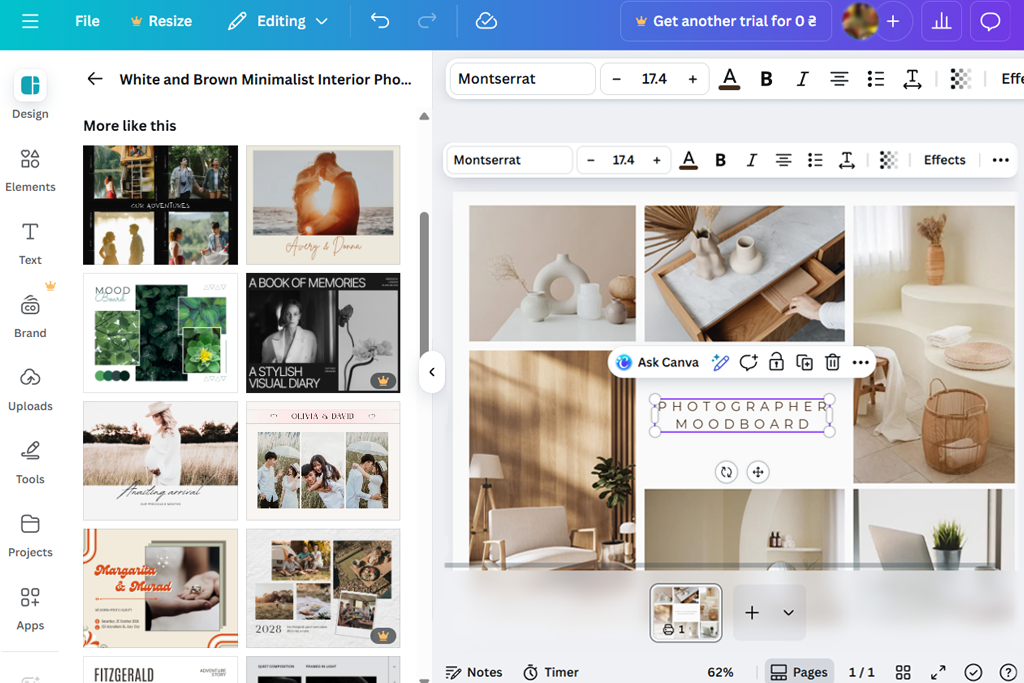
When testing Canva, I began by adding images that helped convey the mood I envisioned and then used the platform’s icons, gradients, and shapes to connect all the elements. For instance, I employed soft overlays that matched the chosen lighting style and fabric swatches to ensure the entire mood board had a cohesive feel to it.
I also like the provided text tools. They let me add keywords, notes, and little quotes to help me remember crucial information relevant to my project or present it to my clients.
I particularly enjoyed the collaborative workflow that this moodboard website brings to the table. I sent the board to my coworker, and they could edit it in real time. Seeing the edits being applied live made the design process feel more engaging and feedback-friendly. That’s why Canva is a great choice for teams that like to bounce ideas off each other.

The thing I liked most about Milanote is how freeing it feels, representing an endless whiteboard that I could organize and fill in as I please using convenient drag-and-drop controls.
I collected an array of reference images, paint swatches, and different textures. Instead of being forced to arrange them inside a fixed grid, I could freely add them to the board, grouping them as I saw fit. I could also connect various elements with arrows, attach sticky notes, and create to-do lists related to the project.
Such a workflow makes the mood board feel a lot more dynamic and “alive.” I particularly enjoyed using this free mood board maker when visualizing ideas that required accounting for seasonal adaptability or specific client preferences.
This storyboard software has also impressed me with how it tackles mixed media files. In contrast to Canva and Pinterest, Milanote doesn’t restrict me to only using images and text. It lets me add links, PDFs, different kinds of notes, etc. During testing, I provided links to various catalogs and flooring samples, ensuring I could easily access all relevant sources from the mood board.
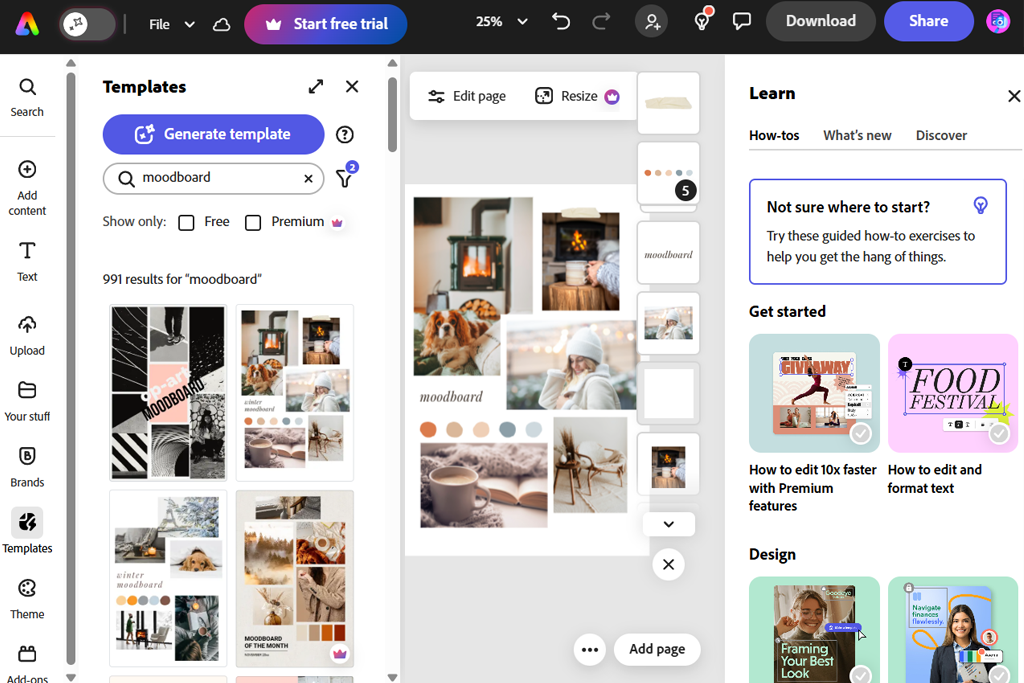
The template library included Adobe Express can be a great jumping-off point for any project. You can simply add your assets to premade layouts and enjoy how they look in a professional context, allowing you to side-step the process of arranging each element by hand.
I also like how Express fits into the rest of Adobe’s software lineup. Since I already have Photoshop and Firefly, I could create and enhance images in other tools while using Express solely as an aesthetic moodboard maker. For my test, I generated several fabric swatches in Firefly, edited them in Photoshop, and then conveniently added them to the mood board I was designing in Express. Since all these tools are made by Adobe, going from one to another feels smooth and intuitive.
The key distinguishing feature of this app is that it has built-in branding functionality. Whereas most apps for fashion designers are designed exclusively for inspiration, Express goes further by letting you add specific colors, fonts, and styles in just a matter of clicks.
This was particularly handy for me since it was important for me to not only set the mood, but also represent my brand. Using consistent fonts and colors across the entire project makes Adobe Express perfect for establishing branding guidelines.
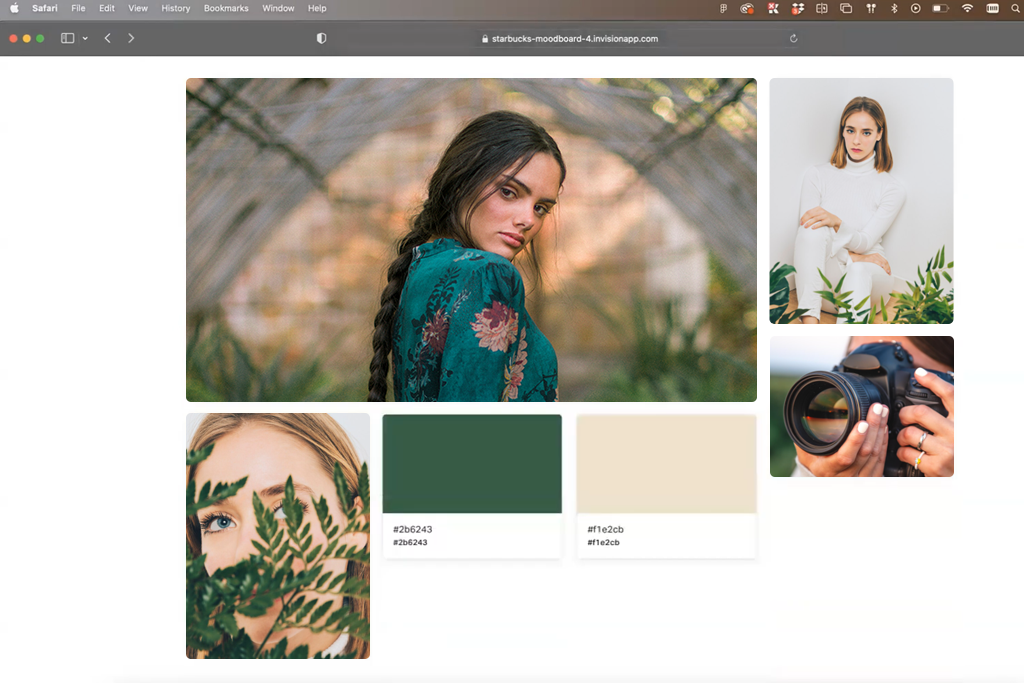
In contrast to Canva and Express, which both rely primarily on templates, InVision provides a decent amount of structure while still letting you get more creative. I especially appreciated its commenting and collaboration features.
I sent the mood board to two coworkers, enabling them to add notes straight to specific elements, suggestions like “apply this gray hue to the footer” or “I think a more casual font would be a better fit for our brand.” Such a convenient feedback loop helped significantly streamline the entire design process.
This solution also stands apart from alternatives because of how it fits into the broader design workflow. After finalizing the mood board, I could switch to wireframes and prototypes without leaving InVision. Such fluidity ensures I stayed on top of things, avoiding the disconnect that typically occurs when switching between different apps. Such integration has been of great benefit to me, allowing me to enjoy a much smoother moodboarding experience.
Like with all other moodboard apps, there are trade-offs. InVision is targeted at digital and product design, making it a suboptimal option for photoshoot or interior design project planning. Learning how to use this tool is also more difficult compared to Pinterest, Canva, and other InVision alternatives, forcing me to dedicate quite a bit of time to get comfortable with the available features.

Moodboard AI is an app that I decided to test when working with one of my loyal clients. They asked for a soft, inviting vibe with neutral hues, cozy textures, and light decor, so I wanted to check if this AI moodboard app could save me time on having to look for all those elements manually.
I was instantly impressed by the speed with which this app produced a concept board. I just had to describe what I wanted, and the AI generated a layout that was close to a perfect match for my vision, featuring the exact style and colors I asked for.
I also enjoyed using the cleanup and upscaling features. If some of the generated images looked subpar, I’d use the cleanup feature to fine-tune the details. This allowed me to fix most flaws without having to use another image editing solution. The generated layouts can also serve as a fantastic foundation, which you can build upon instead of having to make everything from scratch.

When I was checking how FigJam holds up as a mood board app, I wanted to see if it can do more than just serve as a brainstorming and whiteboarding solution. I used it to develop a campaign for one of my clients who required something both entertaining and professional, featuring striking colors, engaging fonts, and an energetic vibe. Usually, I’d rely on an app that specializes in design layouts, but I ended up being satisfied with what FigJam brought to the table.
I began by adding a bunch of photos, color palettes, and some sketches to the canvas. I appreciate the fact that this tool doesn’t limit me to premade templates or grids, instead allowing me to freely arrange all the assets, group them thematically, or add sticky notes to describe my thought process behind specific ideas.
For instance, I made a set of images dedicated to the concept of “energy” with striking neon accents and another batch about “trust” with pastel blues and grays. The unlimited canvas allowed me to try out a bunch of ideas without any restrictions.
I think this photo collage app is particularly well-suited for collaboration. I shared my mood board with two colleagues, and we started editing the board in real time. I was adding logo references, while one of my teammates picked fonts and the other picked the color palette. The visible cursors and live feedback made me feel like we were all in the same room. Such an approach streamlines the overall design process and makes it easier to discuss ideas.
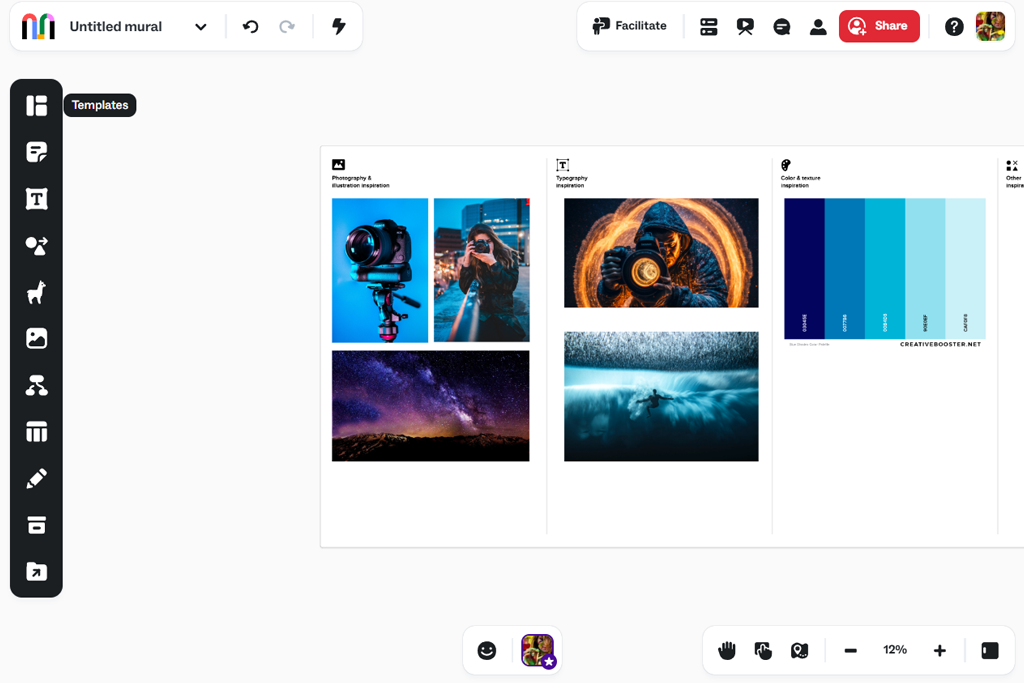
I used Mural to create a moodboard centered on a lifestyle brand shoot. The client asked me to ensure everything looked authentic, warm, and inviting. I wanted a tool that would provide enough space for me to add all the images, typography, and notes I need without everything feeling cramped, and Mural delivered on that front.
This app feels a lot more structured than the other alternatives I’ve tried. Rather than just presenting me with an empty canvas, it offers handy frameworks and templates that help me quickly establish a foundation for my project. I picked a basic grid layout that I separated into sections for color schemes, lighting setups, fabric textures, and theme-relevant keywords. This simplified the task of visualizing the plan for the photoshoot without making everything look clumped together.
Mural also has a leg up on the competition due to its “collaborative workshops” that make it a fantastic productivity app. I leveraged the provided voting tool to ask my coworkers which aesthetic approach we should go with.
One option prioritized earthy tones and organic textures, while the other featured lighter and more saturated colors. This was a lot more efficient than having to ask for everyone’s opinion separately and being stuck in endless debates. The voting feature keeps things democratic while also helping you become a lot more time-efficient than if you were using regular note taking apps.
The other members of the FixThePhoto team and I tried to find the best moodboard app to make life easier for photographers and creatives alike. I collaborated with Kate Debela, Nataly Omelchenko, and Ann Young to thoroughly test every aspect of the apps we chose instead of simply looking at the advertised feature lists.
Our first step was to identify the main needs of anyone who wants to create a moodboard. All of us had a separate project to work on. I was visualizing a photography studio, while Kate, Nataly, and Ann focused on other subjects, from photoshoots to interior design. We tested the performance, user-friendliness, versatility, collaboration tools, and cost of the best mood board apps the market has to offer.
Our testing process was very thorough. We examined the UI of every app and how it handles importing images, color palettes, textures, and other supported assets. If a solution provided AI functionality, we tested it too, along with the available templates or freeform canvases. We made notes on whether the interface is intuitive to navigate, if the drag-and-drop controls are responsive and smooth, and whether the app lets us add notes or comments to streamline the feedback loop.
We also paid a lot of attention to the collaborative functionality of each app. We shared the created boards and commented, annotated, and voted on them to check how the platform handles feedback and communication. This allowed us to determine whether specific moodboard software was suited for team-based workflows.
Lastly, we examined the results. We debated whether the output was presentation-ready, if it does a great job conveying the idea behind the moodboard, and if it can be conveniently integrated into other tools that are a part of our workflow. Once the tests concluded, we brought all our notes together and evaluated all the benefits and drawbacks of every option with the goal of putting together this comprehensive guide.